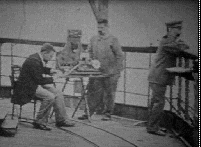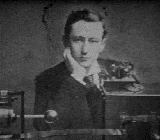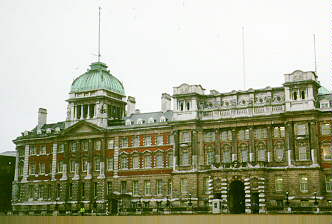
Radio Telegraphy
(... also know as "Wireless")
Wireless communications started with the telegraph ...
|
"We call the electric telegraph the most perfect invention of modern times ... as anything more perfect than this is scarcely conceivable, and we really begin to wonder what will be left for the next generation, upon which to expend the restless energies of the human mind.
"
|

|
|
-- an Australian newspaper, 1853
The wireless telegraph involved radio technology
- Communicate with ships and other moving vehicles
- Messages sprayed into the "ether" crossing natural boundaries
- Downfall of the nationally supported monopolistic telegraph companies

Guglielmo Marconi
Marconi patented a complete wireless system in 1897 and he was the first to give a
demonstration of wireless telegraphy. He built on theoretical work of Maxwell and Hertz to send and receive Morse Code.
The system used long wave (>> 1 km) signals and spark transmitter technology, requiring very large, high power transmitters. The use of large wave lengths also required long antennas. This hindered the development of mobile system, except for maritime (ship-to-shore) communications.
Wireless telegraphy was first used by British Army and Navy in the Boer War.
In 1899, America's Cup yacht races were reported to shore.
Initially, commercial success was hindered by large investments already made
in transatlantic telegraph cables.
After World War II showed the vulnerability of cables, wireless telegraphy was used at larger scale.
Origins of Coded Transmission
- 1793, Revolutionary France - Aerial Telegraph, invented by Claude Chappe - Extensive network throughout France
1840s, Samuel F. B. Morse - Coded transmission via electronic means - Rapidly spread throughout US and Europe
- International Telegraph Union (ITU) formed in 1865
Submarine Telegraphy
High Tech of the late 19th Century
- 1850: Dover-to-Calais, first submarine line
- 1858: First transatlantic cable - Breaks after 3 months! - President Buchanan & Queen Victoria exchange telegrams
- 1866: Relaid with higher quality cable - Development of cable materials, technology of laying, repair
- Typical "Performance": - 1870: London to Bombay in 4 minutes, 22 seconds - 1901: London to British Guiana, 22 minutes - 1924: Telegram around the world in 80 seconds!
 Short wave antennas, recognizable as copper wires of many meters in length, are often seen on Foreign Affairs buildings or on
ambassy rooftops as
shor wave radio transmission provides robust communications
worldwide even if other communications (satellites, cables, fibers)
are disrupted or damaged in times of war.
Short wave antennas, recognizable as copper wires of many meters in length, are often seen on Foreign Affairs buildings or on
ambassy rooftops as
shor wave radio transmission provides robust communications
worldwide even if other communications (satellites, cables, fibers)
are disrupted or damaged in times of war.
Shor wave radio signals, with frequencies between 3 and 30 MHz,
are reflected by the ionosphere.
|








 Short wave antennas, recognizable as copper wires of many meters in length, are often seen on Foreign Affairs buildings or on
ambassy rooftops as
shor wave radio transmission provides robust communications
worldwide even if other communications (satellites, cables, fibers)
are disrupted or damaged in times of war.
Short wave antennas, recognizable as copper wires of many meters in length, are often seen on Foreign Affairs buildings or on
ambassy rooftops as
shor wave radio transmission provides robust communications
worldwide even if other communications (satellites, cables, fibers)
are disrupted or damaged in times of war.